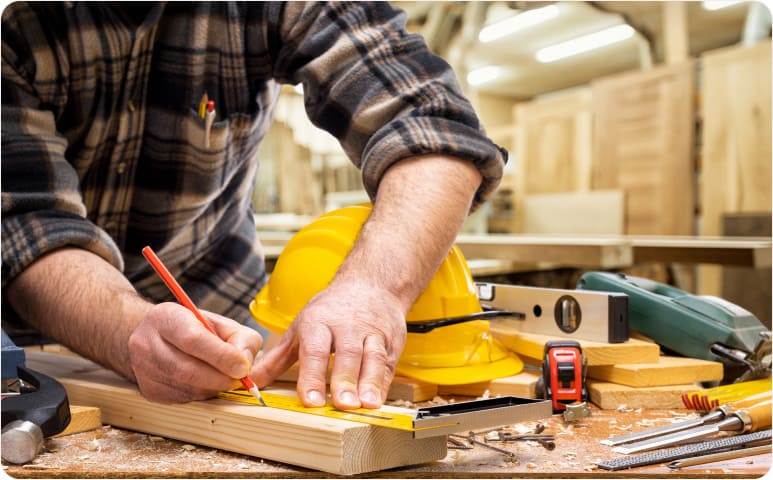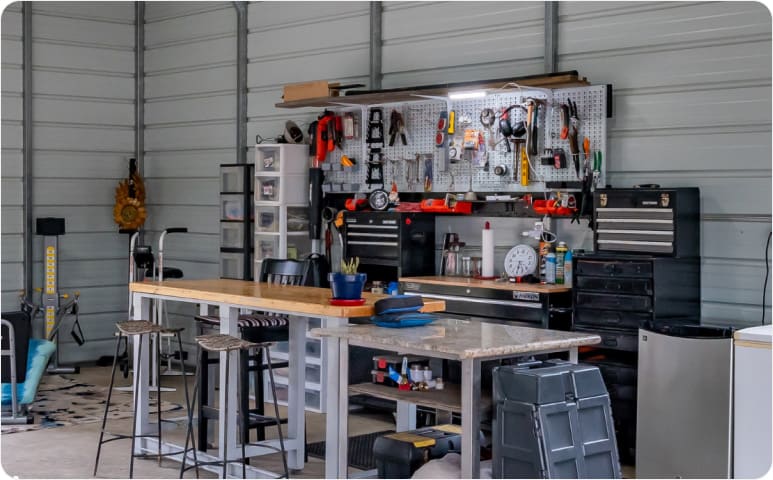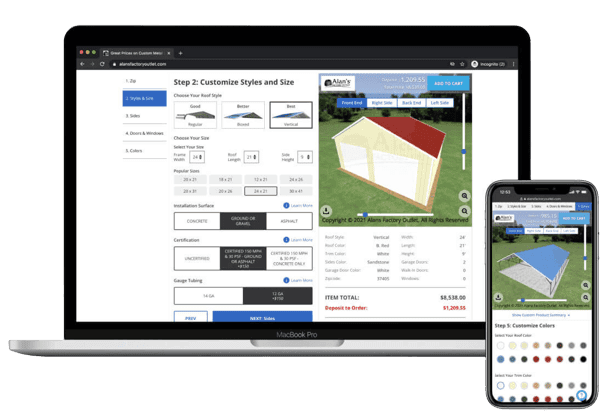Do you have a craft that you’d like to turn into a small, home-based business? If so, now is one of the easiest times in history to get started. Online marketplaces like Etsy have made it possible for small-scale businesses to sell to customers across the country.
If you’re someone who likes to focus on crafting your products more than crafting your business, the Etsy marketplace might be a good place to start your small-business adventure. The following guide provides an overview of steps you can take to start an Etsy business at home and start selling your own products.
Please note that the information on this page is not financial or legal advice. You should always consult licensed professionals to discuss the legal and tax implications of starting a business.
What Kind of Products Can You Sell on Etsy?
Etsy allows sellers to sell handmade items, vintage items (at least 20 years old), and craft supplies. In this guide I’ll focus on handmade items, but most of the same principles will apply if you want to sell vintage items or craft supplies.
Etsy defines handmade items as items that are “made and/or designed by you.” That means you can sell items that you either make by yourself or that you design and others make.
For example, let’s say you design stickers, but you use a production partner to make the stickers. You’re allowed to sell those stickers on Etsy because you’re the designer.
You can also take an existing design and build it yourself. For example, if you make wood furniture following designs created by others, you can sell that furniture on Etsy because you’re the maker.
Of course, you can do both the designing and making if you want to.
Step 1: Set Up Your Home Workshop for Creating Your Product

Before you start making products for sale at home, you need to set up your workshop. For many skilled hobbyists and enthusiasts, a home-based workshop offers an avenue to turn a passion into a viable profession.
One popular option is to convert your garage into a workshop. After you move the cars outside and clean out the junk, you may find you have enough workspace to set up your production process.
If you don’t want to park your cars outside, you can buy an affordable carport or detached garage for your vehicles. Alternatively, you can leave your garage alone and add a stand-alone workshop on your property. Prefabricated workshops are a cost-effective way to expand the space available for your home-based business.
Designing an Efficient Workspace

Careful planning is necessary to maximize space in a garage workshop. Even if you build a new metal garage specifically for your enterprise, you should consider the design carefully based on your workflow and equipment needs.
Here are some tips for organizing an effective home workshop in a garage:
- Clear out your space before starting.
- Develop zones for different tasks. You can increase efficiency by creating defined areas for work benches, tool storage, product assembly, or equipment.
- Use vertical space to eliminate clutter and to save space for working and for using vital equipment on the floor.
- Consider workbench placement, which is essential for efficiency. Position your workbench near electrical outlets and under light fixtures and give yourself enough space to move freely around the bench.
- Place safety equipment like fire extinguishers and first-aid gear in accessible places in case of emergency.
Finally, you need to consider other necessary features, like lighting, ventilation, and climate controls. These elements can add to the cost and complexity of the setup.
Planning for Growth
You might start small, but you want to leave room for growth. As you experience success, you may need to add new equipment, expand the storage area to accommodate more inventory, or even hire other people to help.
You can leave room in your workshop or garage for these expansions or choose a modular or prefabricated building that you can add on to as you grow. Remember that these expansions can bring tax write-offs to offset the cost of the investment.
Step 2: Take Care of Legal Requirements (Permits, Business Registration, Safety Regulations, Insurance)

Before you start any work, your home-based shop needs to meet legal requirements. Although fulfilling them may seem a little overwhelming, all are necessary to operate in a legal setting—let alone to be successful with your business.
Here’s a closer look at some key legal requirements:
Zoning
Zoning laws dictate whether or not you can perform commercial activities in your residence. This requirement can be a hurdle for some home-based shops. Zoning can be confusing because you are usually allowed to perform your trade as a hobby at home. However, if you use the same equipment for a business, you need to make sure it is allowed by your local government.
Registering Your Business
Next, you may need to register your business. This process varies depending on where you live, as registration requirements differ by state. In most states, you’ll have to submit paperwork that defines your business structure. Most small business owners register their business as a sole proprietorship or a limited liability company.
A sole proprietorship may be sufficient if you are working alone. In some states, no registration is required, but you will still be subject to zoning and permitting requirements.
A limited liability company (LLC) provides additional protections. This option may be useful because it allows you to protect personal income and property in liability cases involving your business.
Prioritizing Safety

A fire suppression system, first aid, and equipment safety measures are essential if you will be performing work that involves a risk of injury or fire.
If you will be operating your business in a residential area, you should establish clear safety measures for any friends, neighbors, family members, or customers who might enter your workshop. This could include adding signs and making sure everyone in the house knows the proper safety procedures to follow when in your workshop.
Insurance
While insurance may not be required, it is usually a good idea to protect your business and business assets. Insurance professionals might advise you to consider insuring your workshop and tools—and your life—to protect your family and business in case of a natural disaster, workplace injury, or theft.
Other Legal Requirements
Like any other kind of business, you will need to keep records of income and expenses and pay any required taxes. You can consult with a CPA or tax attorney for details about what is required where you live.
Step 3: Set Up Your Etsy Store
Once you have the legal requirements taken care of, you can start your Etsy shop. Here’s how to do it:
Sign Up and Choose a Shop Name
To create your Etsy shop you’ll need to go to the Etsy website and sign up as a seller. You’ll be asked a few questions and given the opportunity to choose the name of your shop. Don’t worry—you can change your shop name later, so there’s no need to get stuck at this step. You can just go with the best name you can think of, and change it later if you find a name you like better.
Billing Details and Security
Next, you’ll need to set up your payment and billing details so that Etsy can pay you for the products you sell, and you can pay any required fees to Etsy.
Esty also requires that you set up two-factor authentication so that no one can hack into your store. This can be as simple as installing an authenticator app on your phone or getting a code via SMS when you log in.
Store Description and Branding
Finally, you will have a chance to customize the look and feel of your storefront and add some text to tell customers about your business. After that, you can start taking photos and adding products to your Etsy shop.
Step 4: Optimize and Market Your Products

Once you have your store set up, there are two main ways that people will find your products: via search and via referrals.
Etsy Search Engine Optimization
Millions of people go to the Etsy website to search for handmade products. If a customer searches for a product you sell, your product might be shown, the customer might click on your product, and you might get a sale.
So how can you get your product to show up and get attention in Etsy’s search results? Here are four factors that can impact how many people find and buy your products via Etsy search:
- First, you need the right keywords in your product titles and descriptions. If you describe a product as an “old-style bookcase” but buyers are searching for a “rustic bookshelf,” Esty may not show your products because you aren’t using the right keywords. You need to describe your products with the same words that people are searching for.
- Next, you need to have great photos. If your photos aren’t clear and attractive, no one will click on (or buy) your product, and Etsy will bury your products further down in search results where no one will see them at all. Etsy may give your product a boost when you first list it, so it is best to optimize your photos when you first list a product, rather than waiting until later.
- Once your products start selling, you need to make sure you get positive reviews from your customers. This means you should only sell high-quality products and you should provide great customer service (more on this below). Products with great reviews will show up more often in search results than products with poor or average reviews.
- Customers who find your product via an Etsy search probably don’t know you, so your price is another factor you may need to optimize. Selling your product for a little less than the average price of similar products can help you increase your sales, but you need to make sure you’re still making a profit. Once you have an established reputation, you may want to sell some of your hand-crafted items for more than anyone else in order to attract customers who are looking for premium-quality goods.
Marketing
Many people don’t make as many sales as they want only from people finding their products on Etsy, so they use marketing to increase their sales.
Social media platforms are popular places for Etsy sellers to grow an audience of potential customers and market their products. Paid advertising is another way to get more eyes on your product.
Step 5: Fulfill Orders and Provide Great Customer Service

This final step of starting a craft-based Etsy business is arguably the most crucial to the success of your Etsy shop. In a sea of competition, the best way to stand out in your customers’ minds is to be truly outstanding in fulfilling orders and delivering customer service. Here are some key things to keep in mind:
- Since we live in a world of “fast and free shipping,” customers may give you a bad review simply for receiving an order a day later than expected. Prompt shipping is perhaps the number-one way to provide customers with a good experience.
- Also, consider how you package your products. You may be tempted to cut corners on padding and packaging, but if your product arrives damaged, you’ll have an unhappy customer.
If you’re selling premium-priced products, customers probably expect premium packaging and premium service. For example, when you buy an iPhone, it doesn’t come in a cheap, used cardboard box. Apple purposely crafted the unboxing experience to delight and impress. So consider your customers and make sure your packaging and shipping speed match their expectations.
- If you get customer complaints, be sure to handle them with grace and compassion. A snarky reply to a bad review can kill your reputation. Losing money on one sale is a lot better than losing dozens or hundreds of sales from a bad reputation. If you handle each customer complaint with the patience and service you would want to receive as a customer, you’ll rarely go wrong.
- Great customer service can lead to loyalty, repeat business, and referrals—and strong customer communication is key to great service. If you’re fulfilling a custom order that will take several days or weeks to complete, be sure to provide your customer with regular updates, especially if you run into an unexpected delay.
Have Fun!
Starting a craft-based Etsy business can be a lot of work—but it can also be a rewarding adventure. With some careful planning, you can avoid many mistakes and have fun setting up your business.
I wish you success in your creative enterprise, and if you ever need a metal building as you expand your business, give me a call and I’ll be glad to help.





